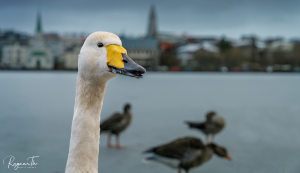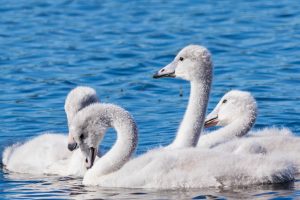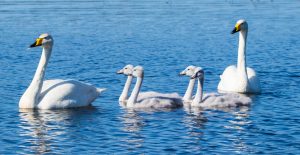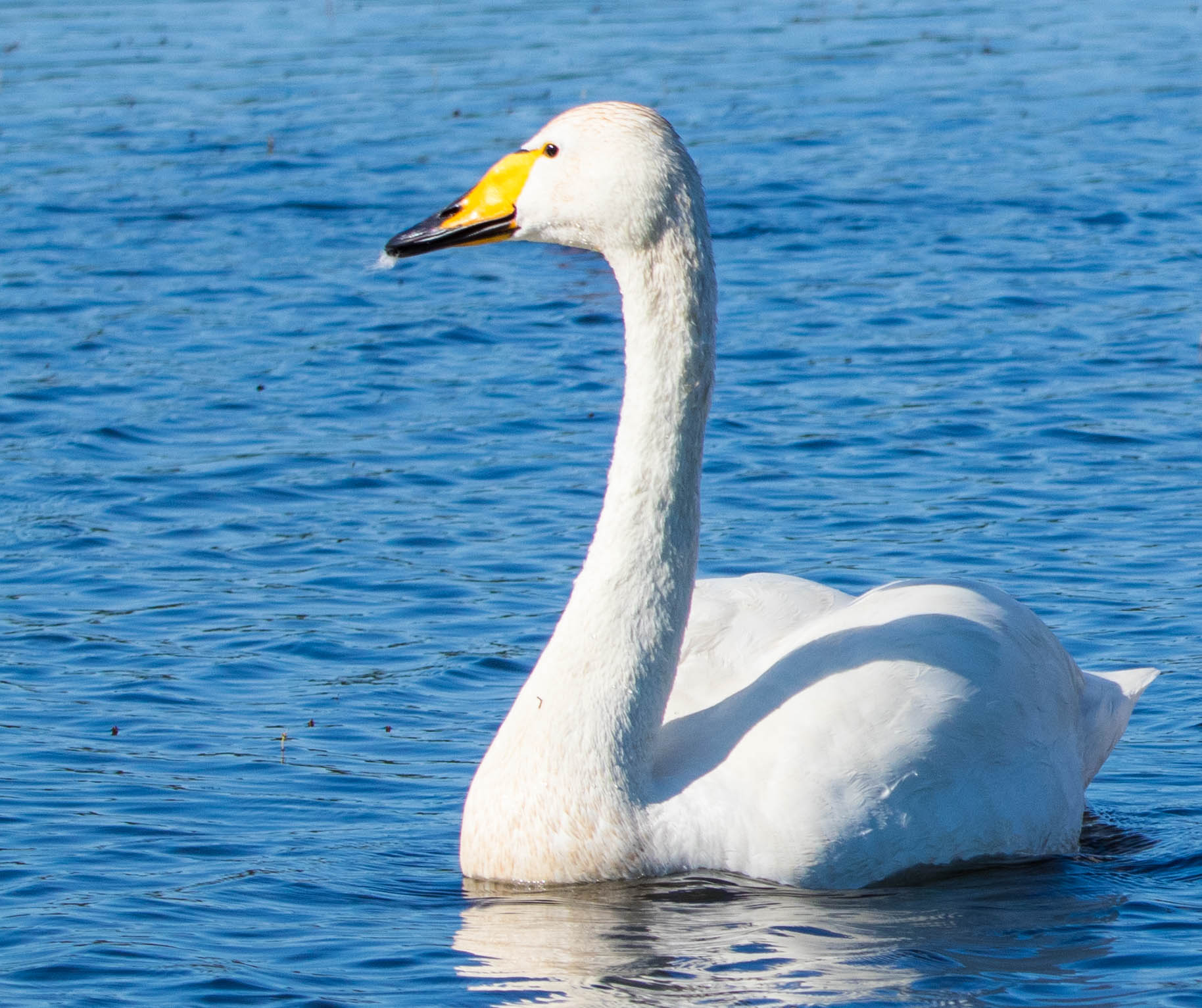There is something romantic and adventurous about swans (Cygnus), who appear in many fairy tales as a symbol of purity and innocence. The loyalty a swan couple have to each other and to their breeding site is well known and appeals strongly to people. The whooper swan (Cygnus cygnus), sometimes called the common swan, belongs to the order Anseriformes along with geese and ducks but is the only species in Iceland that belongs to the genus Cygnus.
Size matters
It is easy to recognize whooper swans by their white color, long necks, and great size. An adult whopper swan weighs 13-26 lbs and is one of the world’s largest flying birds. To bring such a massive body to flight, swans need a good runway to flap their big wings. The wingspan of a whooper swan can exceed 100 in. A full-grown bird has black feet and a yellow bill with a black tip. Juveniles have a dark bill and feet. They are light gray but become whiter with age, maturing at the age of 3-6 years. The whooper swan is the largest bird in Iceland. Not even the white-tailed eagle (Haliaeetus albicilla) comes close in size to a full-grown male swan.
To maintain such a large body, the whooper swan must feed heavily on plants and herbs. During spring and summer, they stay in wetlands and feed on all kinds of water plants. They also stay close to the seashore where they feed on common eelgrass (Zostera marina) and seaweed. Whooper swans often feast on farmers’ crops in large numbers. During spring and fall, they can cause great damage to grass-, grain- and potato fields.

Did you know?
- Whooper swans’ feathers were very expensive when people used them for writing in the old days.
- Whooper swans are strong birds and aggressive in the breeding season. They can kill sheep and dogs, and even hurt adults badly with their strong wings. It is not advised to go near a whooper swan nest.
- An adult whooper swan weighs up to 26 lbs and is one of the world’s largest flying birds.
- The wingspan of whooper swans can reach 100 in.
- Icelandic whooper swans have been protected by law since 1914.
Swans in Iceland
Whooper swans live all around the country, both in the highland and lowland. The Icelandic population has risen in recent years, reaching 30-35 thousand birds in the fall. The breeding population is 5-6 thousand pairs. Most of them migrate to Great Britain in the fall and return in the spring. A small group of swans, however, also stay in Iceland during the cold winter months, mostly on the West- and Southcoast. They also stay at lake Mývatn and at the pond in the center of Reykjavík.
As for other waterfowl, the whooper swans molt their wing feathers in late summer and become flightless. People call this state “being hurt” since the wings often get quite bloody in the process. Back in the old days, Icelanders took advantage of the birds’ helplessness during molting and killed them for meat consumption. The most important molting area for Icelandic whooper swans is at Lón in eastern Iceland, where thousands of swans molt their feathers. About one-third of the Icelandic population go to Lón during the peak molting period.

Family life
Whooper swan couples have their own territory during the breeding season, which it defends against other swans and birds. Their territory is usually close to a lake or a pond where the birds build large nests for the females to lay 4-6 white eggs. The nest is a large pile of vegetation from the surroundings, lined with down and feathers from the birds. Whooper swans often use the same nest for many years if breeding is successful there. The female swan incubates for 35 days while the male defends their territory. Both sexes care for the Cygnus and the family stays together until leaving the country in late fall. Whooper swans pair for life and couples are mostly loyal to each other, though divorces and affairs are known among them. The whooper swan can reach old age, even late thirties.

Fairytales, folklore, and fashion
The mystique around swans has been an inspiration for countless writers and poets, resulting in fairytales and poetry in Iceland and abroad. One famous Icelandic fairytale is “Dimmalimm” (by Muggur, Guðmundur Pétursson Thorsteinsson) from the year 1921. In the story, the love of the princess Dimmalimm saves a prince from a curse which had him trapped as a swan. There is also a musical for the story (by Atli Heimir Sveinsson), which is regularly set up in theaters.
Swans also touched the heart of the world-famous writer H.C. Andersen, when he wrote the story “The ugly duckling” in 1843. There, a Cygnus gets lost and stumbles upon a duck nest where it is bullied because he looks so different from the ducklings. But like many other fairytales, the story has a happy ending.
Swans’ elegant grace has been a source of inspiration for many famous music and dance projects. The Swanlake (by Pjotr Iljitsj Tsjaíkovskíj) is one of the most famous works based on the beauty of swans.

The most famous dress in history?
Swans have also impressed fashion designers for decades and many dresses resemble the white plumage of swans. One of Iceland’s most famous singers, Björk Guðmundsdóttir, showed her affection for swans when she wore an unforgettable dress to the Oscars in 2001. It was a moment that went down in history.
Whooper swan links
- Some key information from The Royal Society for the Protection of Birds
- A few words about swans
- What Birds of Britain wrote about swans
- Information and images from Oiseaux
- Whooper swans singing and dancing
Author: Dr. Þórður Örn Kristjánsson
Photographers: Dr. Þórður Örn Kristjánsson & Ragnar Th. Sigurðsson

